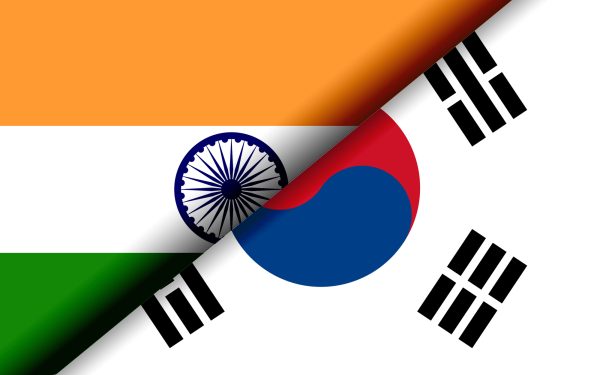As the global economy undergoes disruption due to the Trump administration’s recent tariffs, major export-led economies like South Korea face an urgent need to diversify by tapping into untapped trade opportunities with emerging economies like India. In a recent effort to spotlight and strengthen this partnership, the Embassy of India in Seoul, together with the Korea Institute for International Economic Policy (KIEP), hosted the “Korea-India Economic Partnership Forum: Shaping the Future of the Indo-Pacific.” Attended by diplomats, business leaders, scholars and business consultants, the forum was organized to review the achievements of India-South Korea trade relations and explore ways to advance economic cooperation between two countries.
The forum addressed several themes such as the growing geopolitical importance of the Indo-Pacific; the achievements and persisting challenges in bilateral trade and investment; and the identification of sectors that have high potential for future cooperation. Indian Ambassador to South Korea Amit Kumar pointed to growing Korean investments and business interests in India while also highlighting greater opportunities in the sectors such as shipbuilding, green hydrogen, and EV technologies. KIEP President Siwook Lee emphasized the need for crucial engagement, citing the Indo-Pacific’s growing importance and vulnerability.
Various business leaders from major South Korean conglomerates such as Hyundai and LG shared their success stories in India, highlighting the reputation their brand names have earned among Indian consumers. Meanwhile, startups like Balance Hero shared how they have scaled their businesses by targeting the huge market of Indian youngsters.
It was widely accepted that while ties have deepened, the real scope for collaboration in economic cooperation is yet to be fully realized.
India has not only emerged as the fastest growing major economy, but it is increasingly taking a more prominent role on the global stage. India’s geopolitical importance in the Indo-Pacific and its strategic autonomy, combined with a democratic legal system, enables it to attract strategic, economic and technological partnerships, positioning it as a key player in global supply chains in the foreseeable future. Some other significant factors from an economic standpoint are India’s demographic dividend, huge market, rising middle class (leading to robust and stable domestic demand), increasing purchasing power parity, stable government, ongoing infrastructural development, digital transformation, and tech savvy labor force, making it attractive for foreign investments. The cherry on the top is the push for “Make in India,” which welcomes and incentivizes foreign companies to set up domestic manufacturing, infrastructure, and digital innovation.
On the other hand, South Korea brings to the table expertise in advanced manufacturing, heavy electrical machinery, experience in establishing global supply chains and capital intensive technologies. South Korea has the world’s largest shipbuilding industry, and is a top producer of semiconductor and electronic products. Its defense exports have also experienced substantial growth, including to India. During his speech in the forum, Kumar highlighted the success of Korean K9 howitzers in India, stating that “the second order of a hundred such units will help catalyze further defense collaborations.”
Bilateral trade between India and South Korea has reached approximately $25 billion, reflecting growing engagement between the two economies. Major Korean companies such as Samsung, Hyundai, LG, Kia, and POSCO have already established a strong roots in the Indian market. Samsung runs one of its largest mobile phone manufacturing facilities globally in Noida, while Hyundai has made India a key export hub for its vehicles. Government initiatives like the 2009 Comprehensive Economic Partnership Agreement (CEPA) and Korea Plus Desk have further boosted Korean investment in India. South Korea’s recent push to cooperate with India’s space agency is also seen as an important step in deepening the relationship in the space sector as well.
However, despite these developments, the full realization of opportunities remains largely untapped, especially considering the Trump 2.0 tariffs and the need for diversification of South Korea’s export markets. There is a high potential for deeper trade and investment cooperation between the two countries than what has been achieved so far. Professor Sandip Kumar Mishra of Jawaharlal Nehru University, India pointed that there is an urgent need to “walk the talk” – emphasizing the importance of converting good intentions into action-oriented progress.
India and South Korea’s complementary needs – New Delhi’s demand for high-tech investment and infrastructural development alongside Seoul’s pursuit of market diversification – underline a significant convergence that places them as natural partners in an increasingly volatile global economy. In order to realize the full potential of their economic relationship, both India and South Korea need to pursue more proactive and focused policy strategies.
Seoul needs to look beyond its long-standing preoccupation with the United States and China and develop a committed India strategy that draws on the size and energy of the Indian economy. While Korean firms have been quite successful in consumer electronics and consumer goods, shipbuilding, defense, and infrastructure are sectors of untapped potential, where South Korea’s strengths can directly address India’s developmental needs. While going up against entrenched players like Japan, South Korea can step up investment in transport infrastructure and become a credible defense partner proactively, gaining from India’s initiatives to diversify away from traditional suppliers like Russia and the United States.
At the same time, New Delhi must more strongly highlight South Korea’s strength in high-tech manufacturing, technology, and defense exports, and justify policies to attract Korean capital and technology. Institutional mechanisms such as regular high-level economic summits, sector-specific consultations with specific targets, and intensified CEPA negotiations should be given top priority. As India continues to be the one of the world’s largest arms importers and South Korea becomes a serious defense exporter, this complementarity – if combined with political will – can form the basis of a stronger, more enduring partnership.
In a time of global uncertainty and re-aligning alliances, India and South Korea both have the chance and the imperative to build a forward-looking economic relationship that addresses the Indo-Pacific’s strategic imperatives.


